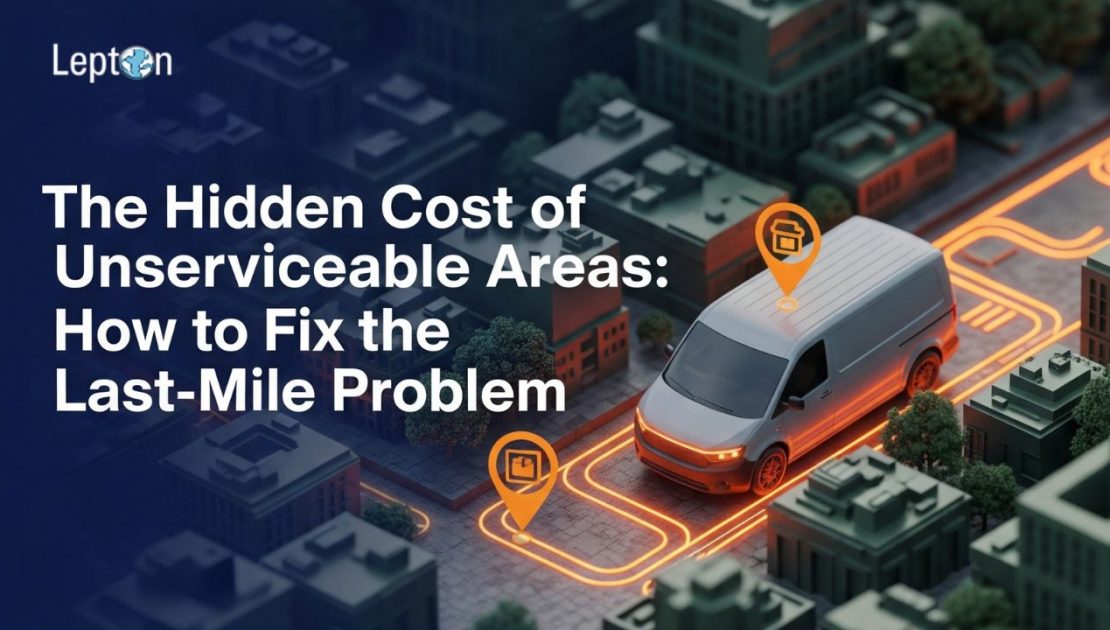The last leg of a delivery commonly called the last mile is often the most difficult and expensive part of logistics. In fact, it can make up nearly 28% of total delivery costs. While fuel prices, traffic delays, and delivery windows are often considered, there’s one issue that usually goes unnoticed: unserviceable areas.
These are places where deliveries can’t be made due to bad infrastructure, restricted access, poor data, or inefficient systems. And they silently increase your costs, cause delays, and lead to unhappy customers.
1. What Are Unserviceable Areas and Why They Matter?
Unserviceable zones are locations that are either too difficult or too costly to reach. The reasons vary:
- Incomplete or inaccurate addresses
- Locked buildings or gated communities
- Narrow lanes or lack of parking
- Time-based restrictions or limited access hours
These small issues lead to big problems:
- Missed Deliveries = Extra trips, higher fuel costs, and unhappy customers
- Empty Returns = Drivers return without completing deliveries
- Overcompensation = More vehicles or buffer inventory deployed than needed
These issues hurt your profitability and customer experience—especially in industries like e-commerce, logistics, and QSR, where last-mile connectivity is crucial.
2. The Cost Impact of Ignoring These Zones
Here’s how unserviceable areas directly affect your business:
| Hidden Cost | Impact on Business |
| Failed deliveries | Higher costs, more manual work |
| Fuel and time wastage | Reduced efficiency, higher carbon footprint |
| Idle or underutilized fleets | Poor ROI on logistics investments |
| Customer dissatisfaction | Lost sales and brand trust |
3. How to Fix the Last-Mile Problem
Use Smarter Route Planning
Don’t just use basic routing tools. Layer your routes with real-time data like traffic, weather, and block-level access info. This helps avoid areas prone to delivery failures.
Apply Area Mapping & Geospatial Analytics
Using GIS-based planning, logistics teams can identify hard-to-serve areas in advance. This allows for rerouting and better resource allocation.
Validate Addresses Before Dispatch
Leverage address validation APIs to confirm serviceability before accepting orders. This reduces failed deliveries and unnecessary redelivery attempts.
4. Create Local Delivery Hubs
Launching micro-fulfillment centers closer to dense but hard-to-reach areas can help. Group deliveries by region and schedule consolidated drops—maybe even offer customers a fixed delivery day per week.
This not only cuts costs but improves delivery reliability.
5. Offer Flexible Delivery Options
Not every parcel needs doorstep delivery. Offer alternate options:
- Lockers or pick-up points at nearby shops
- Delivery to office buildings or staffed locations
- Use gig workers or part-time drivers for specific areas
Flexible delivery models lower your risk in uncertain zones and give customers more control.
6. Use Predictive Analytics to Improve Strategy
Look at past data to find patterns:
- Which areas frequently cause delays or failures?
- Are there zones where returns are common?
Based on this, you can adjust policies—like offering limited delivery windows, or charging extra for known high-risk areas.
7. Monitor KPIs That Actually Matter
Track performance zone-wise to find bottlenecks:
- % of failed or delayed deliveries
- Delivery cost per area
- Distance covered per successful drop
- Customer satisfaction by location
Use geo-heatmaps to visualize which areas are driving costs and which are working well.
Conclusion
Unserviceable areas may seem like a small problem—but they can quietly drain resources, increase costs, and ruin customer satisfaction. The good news? You can solve this with the right mix of location intelligence, routing tools, address validation, and predictive planning.
Start by identifying the zones where you’re losing efficiency, and build strategies around them. In doing so, you’ll turn your last-mile network from a cost center into a competitive advantage.

